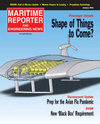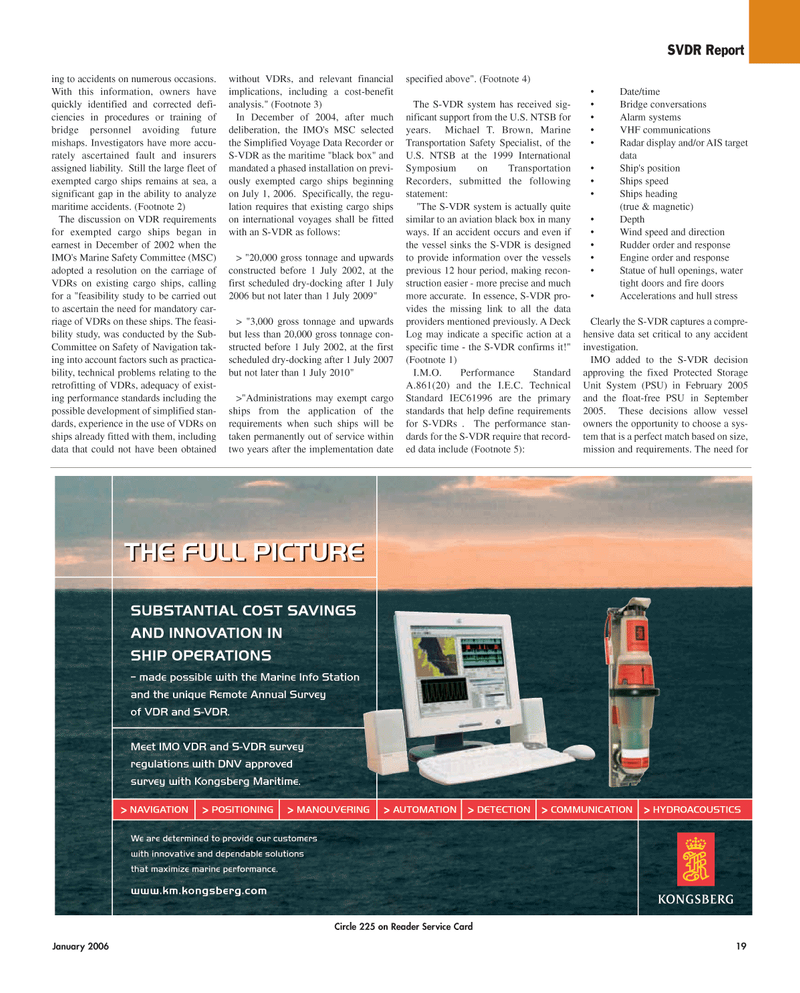
Page 19: of Maritime Reporter Magazine (January 2010)
Ship Repair & Conversion
Read this page in Pdf, Flash or Html5 edition of January 2010 Maritime Reporter Magazine
January 2006 19
Circle 225 on Reader Service Card >
NAVIGATION >
POSITIONING >
MANOUVERING >
AUTOMATION >
DETECTION >
COMMUNICATION >
HYDROACOUSTICS
We are determined to provide our customers with innovative and dependable solutions that maximize marine performance. www.km.kongsberg.com
SUBSTANTIAL COST SAVINGS
AND INNOVATION IN
SHIP OPERATIONS – made possible with the Marine Info Station and the unique Remote Annual Survey of VDR and S-VDR.
Meet IMO VDR and S-VDR survey regulations with DNV approved survey with Kongsberg Maritime.
THE FULL PICTURE
SVDR Report ing to accidents on numerous occasions.
With this information, owners have quickly identified and corrected defi- ciencies in procedures or training of bridge personnel avoiding future mishaps. Investigators have more accu- rately ascertained fault and insurers assigned liability. Still the large fleet of exempted cargo ships remains at sea, a significant gap in the ability to analyze maritime accidents. (Footnote 2)
The discussion on VDR requirements for exempted cargo ships began in earnest in December of 2002 when the
IMO's Marine Safety Committee (MSC) adopted a resolution on the carriage of
VDRs on existing cargo ships, calling for a "feasibility study to be carried out to ascertain the need for mandatory car- riage of VDRs on these ships. The feasi- bility study, was conducted by the Sub-
Committee on Safety of Navigation tak- ing into account factors such as practica- bility, technical problems relating to the retrofitting of VDRs, adequacy of exist- ing performance standards including the possible development of simplified stan- dards, experience in the use of VDRs on ships already fitted with them, including data that could not have been obtained without VDRs, and relevant financial implications, including a cost-benefit analysis." (Footnote 3)
In December of 2004, after much deliberation, the IMO's MSC selected the Simplified Voyage Data Recorder or
S-VDR as the maritime "black box" and mandated a phased installation on previ- ously exempted cargo ships beginning on July 1, 2006. Specifically, the regu- lation requires that existing cargo ships on international voyages shall be fitted with an S-VDR as follows: > "20,000 gross tonnage and upwards constructed before 1 July 2002, at the first scheduled dry-docking after 1 July 2006 but not later than 1 July 2009" > "3,000 gross tonnage and upwards but less than 20,000 gross tonnage con- structed before 1 July 2002, at the first scheduled dry-docking after 1 July 2007 but not later than 1 July 2010" >"Administrations may exempt cargo ships from the application of the requirements when such ships will be taken permanently out of service within two years after the implementation date specified above". (Footnote 4)
The S-VDR system has received sig- nificant support from the U.S. NTSB for years. Michael T. Brown, Marine
Transportation Safety Specialist, of the
U.S. NTSB at the 1999 International
Symposium on Transportation
Recorders, submitted the following statement: "The S-VDR system is actually quite similar to an aviation black box in many ways. If an accident occurs and even if the vessel sinks the S-VDR is designed to provide information over the vessels previous 12 hour period, making recon- struction easier - more precise and much more accurate. In essence, S-VDR pro- vides the missing link to all the data providers mentioned previously. A Deck
Log may indicate a specific action at a specific time - the S-VDR confirms it!" (Footnote 1)
I.M.O. Performance Standard
A.861(20) and the I.E.C. Technical
Standard IEC61996 are the primary standards that help define requirements for S-VDRs . The performance stan- dards for the S-VDR require that record- ed data include (Footnote 5): • Date/time Bridge conversations Alarm systems VHF communications Radar display and/or AIS target data Ship's position Ships speed Ships heading (true & magnetic) Depth Wind speed and direction Rudder order and response Engine order and response Statue of hull openings, water tight doors and fire doors Accelerations and hull stress
Clearly the S-VDR captures a compre- hensive data set critical to any accident investigation.
IMO added to the S-VDR decision approving the fixed Protected Storage
Unit System (PSU) in February 2005 and the float-free PSU in September 2005. These decisions allow vessel owners the opportunity to choose a sys- tem that is a perfect match based on size, mission and requirements. The need for
MR JANUARY2006 #3 (17-24).qxd 1/3/2006 3:08 PM Page 19

 18
18

 20
20
